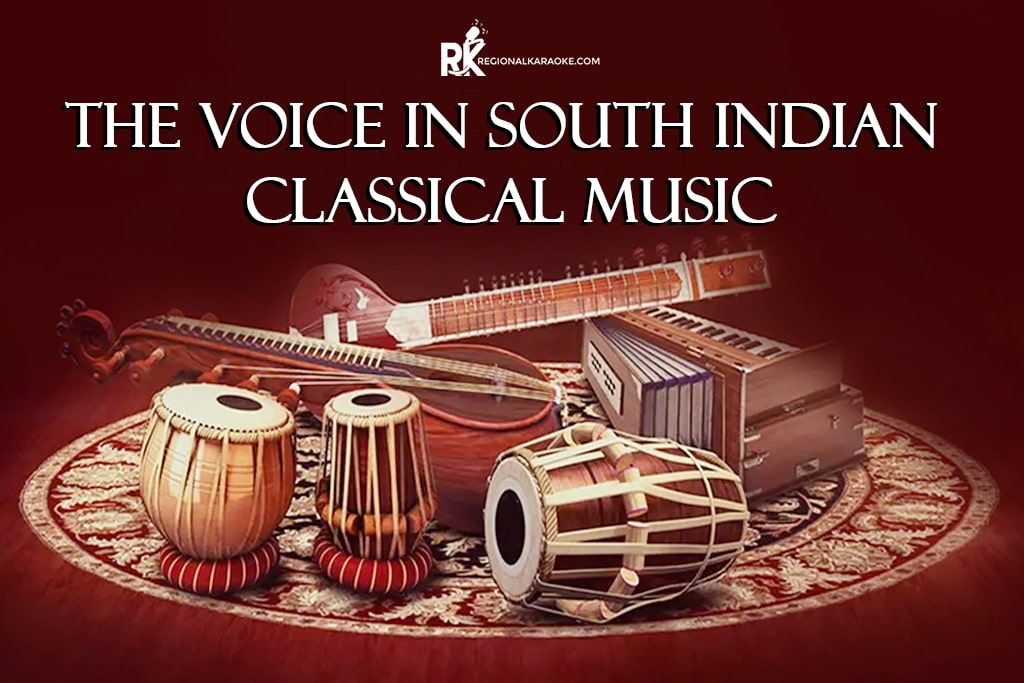Navaratri Store-Wide Karaoke Sale | 30% Off | USE COUPON CODE - NAVRATRI30

- The Foundation: Sargam and Sruti
- The Journey of Training and Practice
- The Cultural Significance
- The Art of Improvisation
- Beyond Entertainment: A Spiritual Journey
- Enhance Your Carnatic Vocal Skills Practicing Techniques and the Role of Karaoke
- Conclusion:
- Establishing a Practice Routine
- Incorporating Karaoke into Practice
- Tips for Effective Karaoke Practice
- Choose Regional Karaoke for easy singing and practicing sessions
The Voice in South Indian Classical Music
In South Indian classical music, the voice is like a magical instrument. Singers in this tradition, known as Carnatic musicians, undergo years of training to become masters of their craft. They learn to sing in different octaves, pitch levels, languages, and musical styles. Carnatic singers practice their melodies using a unique set of syllables called Sargam. They also choose a central pitch, sruti, around which they build their songs. This pitch is like a home base for their singing.
Learning Carnatic music is a lifelong journey that starts with a guru or teacher and continues through daily practice and performances. Concerts can last for hours, showcasing the singer's skill and ability to improvise or create music on the spot.
The Artistry of Carnatic Vocalists
Carnatic vocalists are revered for their unparalleled artistry, honed through years of dedicated practice and study. One of the most striking aspects of their skill set is their ability to traverse a multioctave range with effortless grace. Unlike Western classical singers, who typically operate within a two-octave range, Carnatic vocalists are trained to navigate through at least three octaves, showcasing remarkable vocal control and agility.
Furthermore, Carnatic vocalists boast an extensive repertoire that spans multiple languages, including Sanskrit, Telugu, Tamil, Kannada, Malayalam, and Hindi. This diversity of linguistic expression adds complexity and richness to their performances, allowing them to connect with audiences across cultural boundaries.
Central to the artistry of Carnatic vocalists is their mastery of ragas, the melodic frameworks that form the backbone of South Indian classical music. Ragas are intricate musical structures that evoke specific moods and emotions, and Carnatic vocalists are adept at infusing each rendition with the unique essence of the raga being performed. Through their nuanced interpretation of ragas, vocalists captivate listeners and transport them on a journey of sonic exploration and emotional resonance.
The Foundation: Sargam and Sruti
Carnatic music lies in the system of Sargam, a set of syllables that serve as the foundation for melodic improvisation. Like the solfege syllables used in Western classical music (Do Re Mi Fa La Ti Do), Sargam syllables—Sa Re Ga Ma Pa Dha Ni Sa—are used by Carnatic vocalists to navigate the intricate terrain of ragas and compositions.
Additionally, Carnatic vocalists must select a central pitch (Sa) around which their performance revolves. This pitch, known as sruti, provides a harmonic anchor for the vocalist and is sustained throughout the performance. Whether through the traditional accompaniment of the tambura or the modern convenience of the sruti box, the chosen sruti creates a sonic backdrop against which the melody unfolds, adding depth and resonance to the performance.
The transmission of Carnatic music is deeply rooted in oral tradition, with knowledge passed down from guru to disciple through years of dedicated study and practice. This traditional pedagogical approach ensures the preservation of the rich musical heritage of South India and fosters a deep sense of reverence and respect for the art form.
The Journey of Training and Practice
Becoming a proficient Carnatic vocalist is no small feat and requires a lifelong commitment to learning and artistic refinement. Daily lessons and intensive study periods spanning ten to twenty years are standard for aspiring vocalists, who dedicate themselves wholeheartedly to mastering the intricacies of the art form.
Even after years of training, the learning journey continues indefinitely as musicians constantly strive for artistic growth and development. This commitment to lifelong learning is a testament to the depth of passion and dedication that Carnatic vocalists bring to their craft, ensuring the tradition remains vibrant and alive for generations.
The Cultural Significance
Carnatic music is not just about singing melodies; it's deeply rooted in South Indian culture and holds great importance. It's a way for people to express their emotions and connect with their spiritual beliefs.
This music helps create a sense of belonging and identity for those who perform and listen to it. It's a way to preserve and celebrate their cultural heritage. Through Carnatic music, people from different backgrounds and communities can unite, united by their love for this art form. It shows how music can improve language and cultural differences, bringing people closer. Carnatic music is a beautiful expression of South Indian culture, enriching the lives of those who experience its melodies and rhythms.
The Art of Improvisation
Central to the Carnatic tradition is mano dharma, or improvisation, wherein the vocalist explores and expands upon the musical themes presented in a composition. Through intricate melodic elaborations known as alapana and Swara Kalpana, the artist delves deep into the essence of the raga, exploring its myriad possibilities and infusing it with their creative flair. This spontaneous interplay between the artist, the raga, and the rhythm ensemble creates moments of superiority, captivating audiences and evoking a sense of wonder.
Beyond Entertainment: A Spiritual Journey
For both the performer and the listener, Carnatic music transcends mere entertainment; it is a spiritual journey that transcends the boundaries of the mundane world. Through the power of the voice, listeners are transported to a realm of profound beauty and transcendental bliss, where the world's worries fade away, and the soul finds solace in the divine melodies. In this sacred space, the voice becomes a conduit for transcendence, uniting the performer and audience in a shared experience of ethereal bliss.
Enhance Your Carnatic Vocal Skills Practicing Techniques and the Role of Karaoke
Mastering Carnatic vocal music requires dedication, perseverance, and a structured approach to practice. Whether you're a beginner embarking on your musical journey or an experienced vocalist seeking to refine your skills, incorporating effective practice techniques is essential for growth and development. Additionally, utilizing karaoke as a practice tool can benefit you by honing your Carnatic vocal abilities. Let's explore some practical tips on practicing effectively and the advantages of integrating karaoke into your regimen.
Establishing a Practice Routine
- Warm-Up Exercises: Begin each practice session with vocal warm-up exercises to loosen your vocal cords and improve flexibility.
- Scales and Exercises: Practice fundamental scales (sarali varisai) and vocal exercises (sadhakam) to strengthen your voice, improve pitch accuracy, and develop control over your vocal range.
- Composition Study: Dedicate time to learning and memorizing Carnatic compositions (kritis), focusing on understanding the nuances of melody, rhythm, and lyrics.
- Raga Exploration: Explore ragas by singing alapana and Swara Kalpana and experimenting with different phrases and melodic patterns.
- Rhythm Practice: Work on rhythm exercises (tala alankaras) to sharpen your sense of rhythm and synchronization with percussion instruments.
Incorporating Karaoke into Practice
Karaoke can be a valuable tool for Carnatic vocalists, offering unique advantages that complement traditional practice methods:
- Backing Tracks for Practice: Karaoke tracks accompany the absence of live musicians, allowing you to practice compositions and improvisations with a simulated ensemble.
- Pitch and Rhythm Correction: Karaoke software often includes features for adjusting pitch and tempo, enabling you to fine-tune your performance and address areas of weakness.
- Performance Simulation: Singing along with karaoke tracks simulates the experience of performing on stage, helping you develop confidence, stage presence, and the ability to maintain focus amid distractions.
- Variety of Repertoire: Karaoke libraries offer a wide range of Carnatic compositions in different ragas and talas, allowing you to explore diverse musical styles and expand your repertoire.
- Self-Evaluation: Recording your practice sessions with karaoke tracks allows for self-evaluation, enabling you to identify areas for improvement and track your progress over time.
Tips for Effective Karaoke Practice
- Choose Appropriate Tracks: Select easy-to-go Tamil, Telugu, or Malayalam karaoke tracks that match your skill level and cater to your specific practice goals, whether mastering a particular music composition or refining improvisational techniques.
- Focus on Expression: While practicing karaoke, focus on technical accuracy and emotive expression, infusing each note with feeling and authenticity.
- Experiment and Innovate: Use karaoke to explore creative interpretations of compositions and improvisational passages.
- Seek Feedback: Share your karaoke recordings with mentors, peers, or online communities to receive constructive feedback and valuable insights for improvement.
- Balance with Live Accompaniment: While karaoke can be a helpful practice tool, strive to supplement it with opportunities for live accompaniment, collaborating with musicians to experience the dynamic interplay of a traditional Carnatic ensemble.
Choose Regional Karaoke for easy singing and practicing sessions
At Regional Karaoke, we prioritize your musical journey by offering a diverse selection of Karaoke Tracks tailored to regional preferences, ensuring that you have access to the songs you love to sing and practice. Our extensive library spans various languages, genres, and styles, empowering you to explore and experiment quickly. With user-friendly features and customizable options, our karaoke platform caters to singers of all levels, whether you're a beginner honing your skills or a seasoned vocalist seeking to refine your performance. We understand the importance of convenience and affordability, which is why we strive to provide high-quality karaoke tracks at accessible prices, allowing you to enjoy seamless singing sessions from the comfort of your own home.
Conclusion:
The voice in South Indian classical music represents human expression's boundless creativity and spiritual depth. With its ability to overreach language and culture, it is a universal language that speaks directly to the heart, inspiring reverence and awe in all who encounter its sublime beauty. As we continue to cherish and celebrate this extraordinary tradition, may we be reminded of music's eternal power to elevate the human spirit and unite us in a shared celebration of life's infinite possibilities.
Tags: Karaoke tracks

/The_Musical_Biography_Of_Lata_Mangeshkar_2023-RK.jpg)




